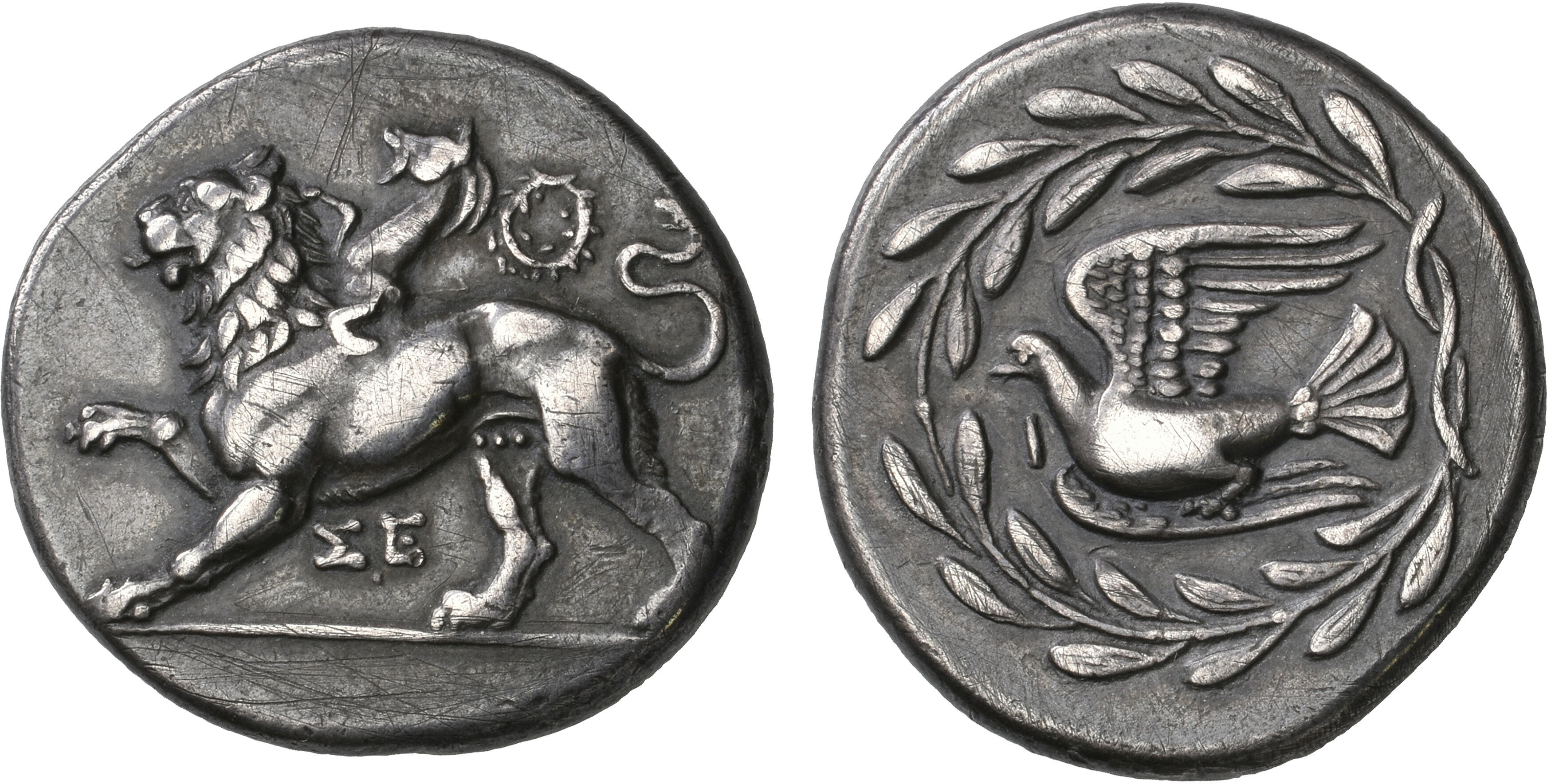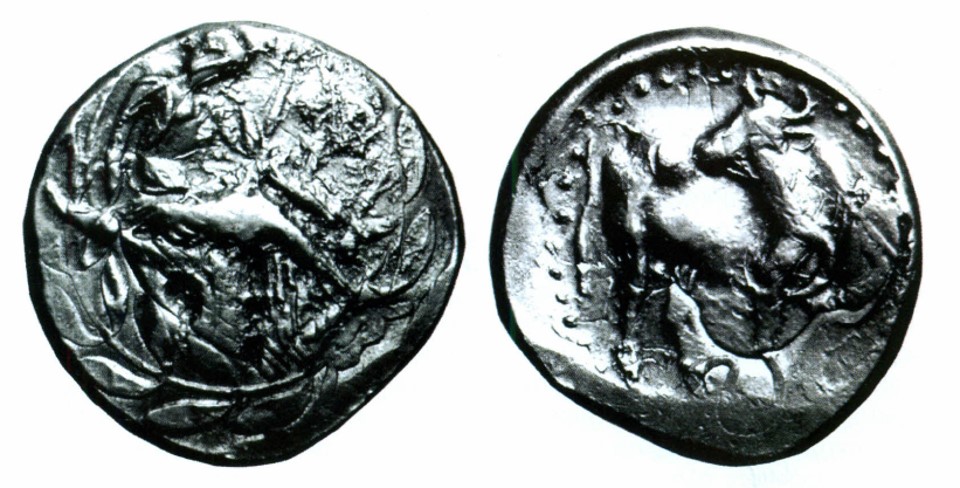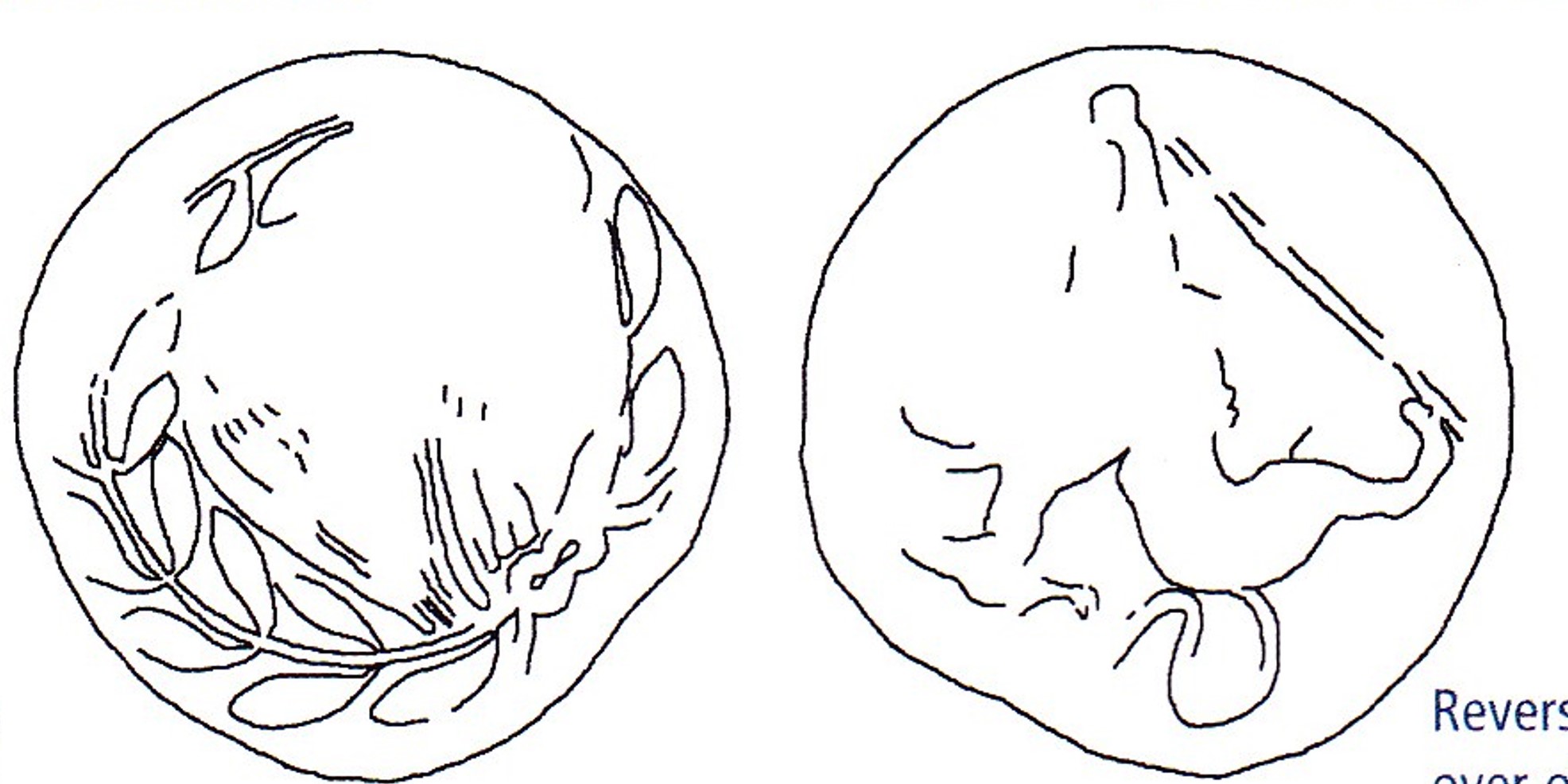3616 - Gortyn (stater Europa/bull) over Sicyon (Chimaera/dove) (MacDonald coll., 114)
From SILVER
330 BCE - 270 BCE
Images
Overstruck variety Traces of the overstruck variety
Traces of the overstruck variety

Sicyon_stater_(Gortyn).jpg [1]
Location/history
| Private collection(s)Private collection(s) ᵖ: | David MacDonald collection, n° 114 |
Overstriking coin
Description
| ObverseInscription or printing placed on the obverse.: | Europa, nude to the waist, seated three quarters right in tree, resting head on left hand | ReverseInscription or printing placed on the reverse.: | Bull right, head reverted. Border of dots. |
Mint and issuing power
| MintIdentifies the place of manufacture or issue of a numismatic object.: | Gortyn | Ancient regionAncient region. | Crete | Modern countryModern country: Greece | AuthorityIdentifies the issuing power. The authority can be "pretended" when the name or the portrait of X is on the coin but he/she was not the issuing power. It can also be "uncertain" when there is no mention of X on the coin but he/she was the issuing power according to the historical sources: |
Chronology
| FromIdentifies the initial date in a range assigned in a numismatic context. 330 BCE toIdentifies the final date in a range assigned in a numismatic context.. 270 BCE | Hellenistic 323-30 BC |
Physical description
| MetalThe physical material (usually metal) from which an object is made.: Silver |
WeightWeight of the numismatic object (in grams). in grams: 11.811.8 g <br />11,800 mg <br /> | DenominationTerm indicating the value of a numismatic object. Examples: tetradrachm, chalkous, denarius.: stater |
AxisDescribes the directional relationship between the obverse and reverse of a numismatic object.: 1212 mm <br />1.2 cm <br /> |
| StandardStandard.: Aeginetic | |||
References
| Coin referenceReference of the Coin: | MacDonald 1996a, p. 49, MacDonald 2009, n° 114 | Coin series referenceReference to coin series study: | Le Rider 19661Le Rider 1966, p. 69-70, n° 30, pl. XV, n° 17-22 (same dies), MacDonald 1996a2MacDonald 1996a, p. 49, MacDonald 20093MacDonald 2009, n° 114 |
| Coin series web referenceCoin series web references: | |||
Overstruck type
Description
| ObverseInscription or printing placed on the obverse.: | ΣΕ (Greek) Chimaera right (visible on reverse: tail, hindquarters, rear leg, under magnification, neck and goat head, most of lion head including some locks of mane, front leg, ΣΕ) | ReverseInscription or printing placed on the reverse.: | Dove flying right, within olive wreath (visible on obverse: two-thirds of olive wreath, upper line of dove's wing, feathers of wing and tail, and outline of dove's head, under magnification, more details of feathers and outline of lower wing). |
Mint and issuing power
| MintIdentifies the place of manufacture or issue of a numismatic object. ᵖ: | Sicyon | Ancient regionAncient region. ᵖ | Peloponnesus | Modern countryModern country: Greece | AuthorityIdentifies the authority in whose name (explicitly or implicitly) a numismatic object was issued. ᵖ: |
Chronology
| FromIdentifies the initial date in a range assigned in a numismatic context. 360 BCE toIdentifies the final date in a range assigned in a numismatic context.. 330 BCE | Classical 480-323 BC |
Physical description
| DenominationTerm indicating the value of a numismatic object. Examples: tetradrachm, chalkous, denarius. ᵖ: | stater |
References
| Coin type referenceReference to coin series study ᵖ: | BMC Peloponnesus4BMC Peloponnesus, n°46-61, LHS 96 20065LHS 96 2006, n° 219, HGC 56HGC 5, n° 201 | ||
| Coin series web reference overstruckCoin series web references overstruck: | |||
Additional data
| Frequency of overstrikesFrequency of overstrikes: | frequent | Level of confidenceLevel of confidence of the identification: | sure |
| RemarksRemarks: | |||
References
- ^ Le Rider, Georges (1966), Monnaies crétoises du Ve au Ier siècle av. J.-C., Paris, Geuthner, 345 p. and 42 pl.
- ^ MacDonald, David (1996), "Mercenaries and the movement of silver to Crete in the late fourth century B.C.," Nomismatika chronika 15, p. 41-52.
- ^ MacDonald, David (2009), Overstruck Greek coins: studies in Greek chronology and monetary theory, Whitman Publishing, Atlanta.
- ^ Gardner, Percy, Stuart Poole, Reginald (1899), British Museum. Catalogue of the Greek coins : Peloponnesus (excluding Corinth), London, lxiv, 230 p., 37 pl.
- ^ LHS 96 2006
- ^ Hoover, Oliver D. (2011), Handbook of Greek Coins 5. Coins of the Peloponnesos, Achaia, Phleiasia, Sikyonia, Elis, Triphylia, Messenia, Lakonia, Argolis, and Arkadia, Sixth to First Centuries BC, Lancaster (PA), 2011.

